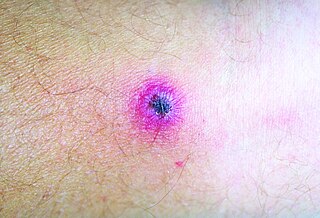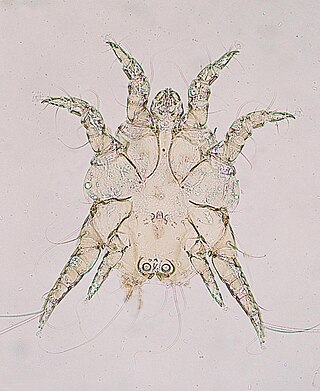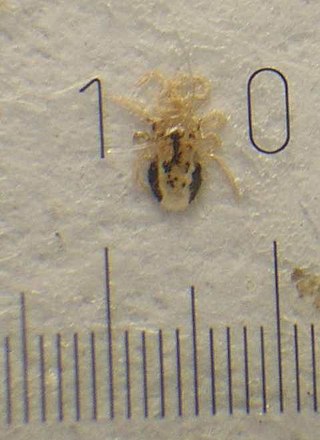Related Research Articles

Mites are small arachnids. Mites span two large orders of arachnids, the Acariformes and the Parasitiformes, which were historically grouped together in the subclass Acari. However, most recent genetic analyses do not recover the two as each other's closest relative within Arachnida, rendering the group non-monophyletic. Most mites are tiny, less than 1 mm (0.04 in) in length, and have a simple, unsegmented body plan. The small size of most species makes them easily overlooked; some species live in water, many live in soil as decomposers, others live on plants, sometimes creating galls, while others again are predators or parasites. This last type includes the commercially destructive Varroa parasite of honey bees, as well as scabies mites of humans. Most species are harmless to humans, but a few are associated with allergies or may transmit diseases.

Sarcoptes scabiei or the itch mite is a parasitic mite that burrows into skin and causes scabies. The mite is found in all parts of the world. Humans are not the only mammals that can become infected. Other mammals, such as wild and domesticated dogs and cats as well as ungulates, wild boars, bovids, wombats, koalas, and great apes are affected.

Rickettsialpox is a mite-borne infectious illness caused by bacteria of the genus Rickettsia. Physician Robert Huebner and self-trained entomologist Charles Pomerantz played major roles in identifying the cause of the disease after an outbreak in 1946 in a New York City apartment complex, documented in "The Alerting of Mr. Pomerantz," an article by medical writer Berton Roueché.

Cheyletiella is a genus of mites that live on the skin surface of dogs, cats, and rabbits.

In medicine, a drug eruption is an adverse drug reaction of the skin. Most drug-induced cutaneous reactions are mild and disappear when the offending drug is withdrawn. These are called "simple" drug eruptions. However, more serious drug eruptions may be associated with organ injury such as liver or kidney damage and are categorized as "complex". Drugs can also cause hair and nail changes, affect the mucous membranes, or cause itching without outward skin changes.

The flour mite, Acarus siro, a pest of stored grains and animal feedstuffs, is one of many species of grain and flour mites. An older name for the species is Tyroglyphus farinae.
Fixed drug reactions are common and so named because they recur at the same site with each exposure to a particular medication. Medications inducing fixed drug eruptions are usually those taken intermittently.
Leptotrombidium deliense is a species of mite.
Grocer's itch is a cutaneous condition characterized by a pruritic dermatitis that occurs from coming into contact with mites such as Carpoglyphus passularum or Glycyphagus domesticus. Contact usually occurs when handling food with mites in it, such as figs, dates, prunes, grain, cheese, or other dried foods.
Grain itch is a cutaneous condition caused by several types of mites, and characterized by intense pruritus.
Wheat warehouse itch is a cutaneous condition caused by a mite, Cheyletus malaccensis.

Kraurosis vulvae or vulvar lichen sclerosus (VLS) is a cutaneous condition characterized by atrophy and shrinkage of the skin of the vagina and vulva often accompanied by a chronic inflammatory reaction in the deeper tissues.
Sulzberger–Garbe syndrome is a cutaneous condition, a type of therapy resistant nummular eczema.
Liponyssoides sanguineus is a species of mite that infests the house mouse.

Psoroptidae is a family of parasitic mites, which are 1–2 mm (0.039–0.079 in) long and live on the surface of the skin, rather than burrowing into it. These mites affect various species, including cats, dogs, rabbits, cattle, sheep, and horses, causing skin inflammation, scabs, crusting, and hair loss.
Ornithonyssus bursa is a species of mite. It is most often a parasite of birds, but also has been found to bite humans and two species of mammals. It usually lives in birds' feathers, but for laying its eggs, it more often uses their nests rather than their feathers. Tropical fowl mites undergo five stages during their development: egg, larva, protonymph, deutonymph, and adult. During the last two stages, they suck blood from their host for food. They are often diurnal, whereas northern fowl mites are nocturnal in nature.

Ornithonyssus sylviarum is a haematophagous ectoparasite of poultry. In both size and appearance, it resembles the red mite, Dermanyssus gallinae.
Feather pillow dermatitis is a rash caused by bites of the mite Dermatophagoides scheremetewskyi.
References
- ↑ Robert L. Rietschel; Joseph F. Fowler Jr. (2008). Fisher's contact dermatitis (6th ed.). Hamilton: BC Decker Inc. p. 428. ISBN 9781550093780.
- ↑ Hill, Dennis S. (2003). Pests of Stored Foodstuffs and Their Control. Dordrecht: Kluwer Academic Publishers. p. 129. ISBN 9780306481314.